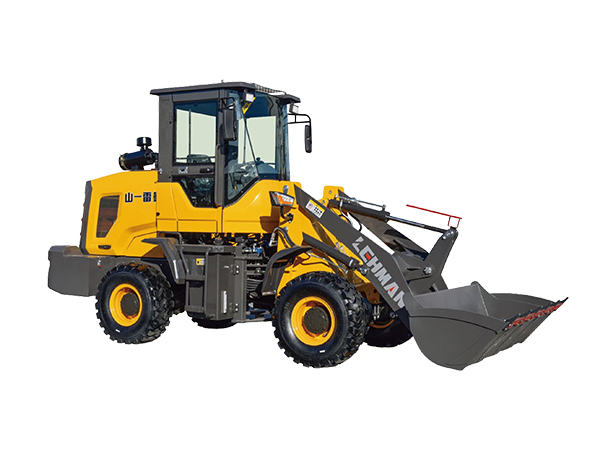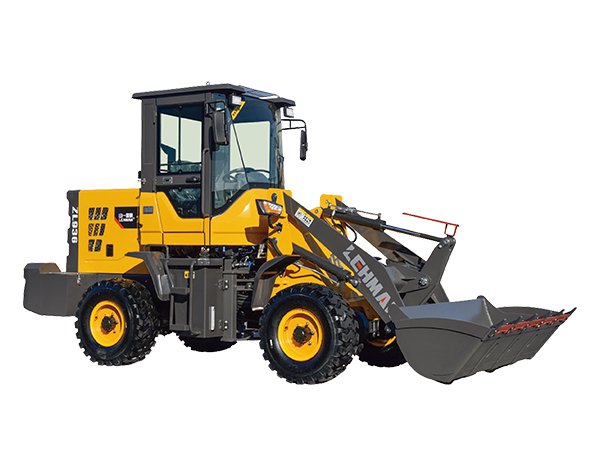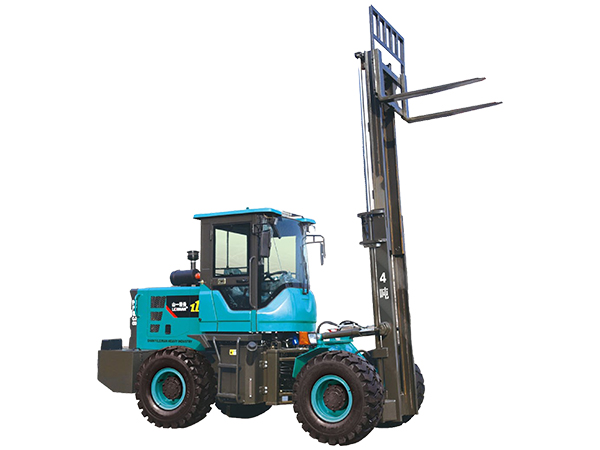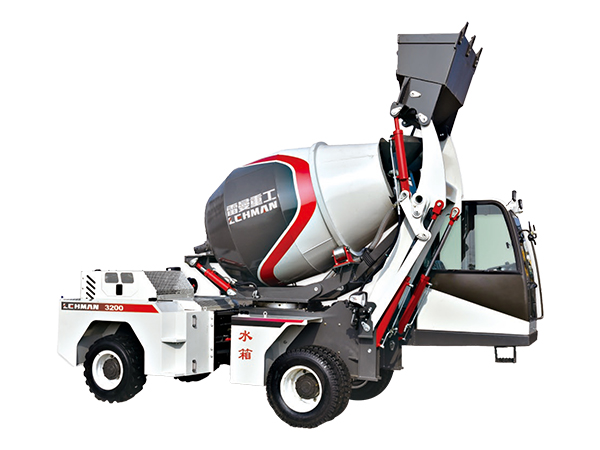Analysis of Loader Failures and Elimination Methods
1 Insufficient brake air pressure
Trouble phenomenon:
The brake failure caused by insufficient air pressure is manifested as the air pressure expression is less than the specified air pressure value (0.45-0.70Mpa), and the brake does not respond when the brake pedal is depressed.
cause of issue:
1) The pipeline is leaking, and there is no pressure or the pressure of the gas in the gas tank is too low, which is not enough to push the afterburner pump set to produce braking force.
2) The air compressor is not working properly and cannot produce enough compressed air.
3) The one-way valve is corroded and stuck, causing inability to enter the air cylinder or slow air intake.
4) The oil drain plug of the oil-water separator is not tightened, causing serious air leakage.
5) The pressure regulating valve leaks seriously.
Troubleshooting:
First, check the air leakage of the pipeline, and then check the working status of the air compressor. Remove the air compressor outlet pipe and press the air outlet with your thumb. If the exhaust pressure is low, the air compressor is malfunctioning. If the air compressor is in good working condition, check the oil-water separator drain plug or pressure regulating valve to avoid bypassing, and finally check the two one-way valves in the three-way joint. If the one-way valve is stuck, it will cause the air reservoir to be unable to go to the air cylinder. Air intake or air intake is slow.
.2 Brake failure
Trouble phenomenon:
When the loader is running, it cannot slow down and stop when the brake is applied.
cause of issue:
1) The brake air pressure is insufficient to push the brake piston to move.
2) The brake valve fails, the piston is stuck or the compensation hole and the vent hole are blocked, and sufficient air pressure cannot be generated.
3) There is air in the brake oil pipe, causing oil pressure fluctuations or insufficient flow, and the brake piston cannot be pushed.
4) There is no brake fluid or insufficient brake fluid, resulting in insufficient amount of brake fluid entering the brake cylinder, the output power of the brake cylinder is low, and the brake piston cannot be pushed.
5) The brake oil pipe is broken or the oil pipe joint leaks, which reduces the amount and pressure of the brake fluid entering the brake cylinder.
6) The piston of the afterburner cylinder is stuck or the sealing ring is damaged, and the output brake fluid oil volume and pressure are reduced.
7) The caliper disc brake cylinder has serious oil leakage, and a large amount of pressure oil leaks, and the brake piston cannot be pushed.
8) The piston in the caliper disc brake cylinder is stuck and the piston cannot move.
9) The brake friction lining has oil stains or is severely worn, the friction coefficient decreases or the brake clearance increases, and the braking force decreases.
Fault judgment and troubleshooting:
1) Check the brake air pressure, eliminate the fault of low brake air pressure, and ensure that the brake air pressure value is 0.45-0.70Mpa.
2) When the brake pedal is stepped on, the air pressure is normal but the brake pedal does not move, indicating that the brake control valve piston is stuck. Disassemble the brake valve, repair or replace.
3) Step on the brake pedal, the pedal position is very low, and when you continue to step on the pedal, the pedal gradually rises, but you feel that the brake pedal is very weak and the braking effect is not good, indicating that there is air in the brake system, which should be eliminated.
4) If you step on the brake pedal continuously, it feels heavy, but the pedal position gradually drops, indicating that the brake system is leaking oil. Check and repair it. If necessary, remove the brake for maintenance and replace the rectangular sealing ring or brake piston.
5) After the air in the oil pipe is exhausted, the brake pedal is still weak. Open the fuel filler cap and find that the brake fluid is violently flipped, indicating that the seals in the caliper disc brake are deformed or damaged. Check and replace the damaged parts. .
6) If the piston in the cylinder of the caliper disc brake is stuck, the piston and the seal should be repaired.
7) When the brake friction lining wears to 1/3 of the original thickness, the friction lining should be replaced to prevent damage to the brake disc.
8) When the brake disc has deep grooves or is severely deformed, the brake disc should be repaired or replaced.
2.3 Braking is not working
Trouble phenomenon:
When the loader is driving, the brake pedal is fully depressed, but it still cannot stop, decelerate quickly, and continue to slide.
cause of issue:
1) There is air in the brake oil pipe or brake cylinder, causing oil pressure fluctuations or insufficient flow.
2) The free stroke of the brake pedal is too large.
3) The brake valve seals, afterburner seals, and brake cylinder seals are severely worn, or the cylinder barrel and piston are severely worn, causing air and oil leakage.
4) The compensation hole or vent hole of the brake valve is blocked.
5) The brake oil pipe is broken or the oil pipe joint is leaking.
6) The gap between the brake disc and the friction plate is too large.
7) The surface of the friction plate is hardened, rivets are exposed or oily.
8) The brake fluid is of poor quality and is easy to evaporate due to heat.
9) The brake pipeline is sunken or blocked.
Fault judgment and troubleshooting:
1) Check the brake air pressure, eliminate the fault of low brake air pressure, and ensure that the brake air pressure value is 0.45-0.70M.
2) The position of the brake pedal is very low when you step on the pedal, and the pedal can gradually rise when you continue to step on the pedal, but the reaction force is small and the braking effect is not good, indicating that there is air in the brake oil pipe or brake cylinder, which should be eliminated.
3) One-foot brake is not effective. When the brake pedal is continuously stepped on, the pedal position gradually rises, and the reaction force is large, and the braking effect is good. It means that the free stroke of the brake pedal is too large or the gap between the friction plate and the brake disc is too large. First check and adjust the free stroke of the brake pedal, and then adjust the gap between the friction plate and the friction disc.
4) Continuously step on the brake pedal and feel heavy, but the position of the brake pedal gradually drops, indicating that the brake system is leaking oil and should be inspected and repaired. If necessary, remove the brake for maintenance, and replace the rectangular sealing ring or brake piston.
5) After the air in the oil pipe is exhausted, the brake pedal is still weak. Open the fuel filler cap and find that the brake fluid has violently flipped, indicating that the seals in the caliper disc brake are deformed or damaged. The damaged parts should be replaced.
6) The pedal position is very low when the brake pedal is stepped on, and the pedal position cannot be raised when the brake pedal is continuously stepped on. Generally, the vent or compensation hole of the brake valve is blocked and should be unblocked.
7) When the brake pedal is stepped on, the free stroke and height of the pedal meet the requirements, and the pedal does not sink weakly, but the braking effect is not good, it is a failure of the caliper disc brake, which may be hardened friction plates, exposed rivets, serious oil pollution, Deformation of the brake disc and other reasons. At this time, the brake should be overhauled, and the brake disc should be polished if necessary.
2.4 Braking deviation
Trouble phenomenon:
When the loader is running, the wheels on both sides cannot be braked at the same time, or one wheel brakes and the other wheel rotates, causing the vehicle to skew to one side, making the vehicle unable to drive in a straight line.
cause of issue:
1) The contact area and gap between the left and right wheels and the brake pads are inconsistent.
2) The friction plates of individual wheels have oil stains, hardening or exposed rivets.
3) The materials of the wheel friction plates on the left and right are inconsistent.
4) There is air in the individual brake cylinders, the movement of the piston is blocked, or the oil pipe is blocked.
5) The tire pressure on the left and right sides is different.
6) Individual brake discs are deformed.
The fundamental cause of braking deviation is the unequal braking force of the wheels on both sides.
Fault judgment and troubleshooting:
When the loader is running, when the foot brake is used, if the vehicle deflects to one side, it means that the wheel brake on the other side has failed. After parking, check the trailing marks of the wheels on both sides on the road. The brakes on the side with short trailing or no trailing marks are not working properly. When it is determined that a wheel is not properly braked, check the deformation of the brake disc and remove the air in the brake cylinder. If it still does not work, disassemble the wheel brake, check the brake cylinder piston and seals, find out where the fault is, and perform necessary repairs.
2.5 Brake drag
Trouble phenomenon:
After the loader brakes, raise the brake pedal, all or individual wheels still have a braking effect, causing the brake disc to heat up and driving weak, commonly known as “braking will not return”.
cause of issue:
1) The free stroke of the brake pedal is too small or the brake pedal return is poor.
2) The control valve piston return spring is too soft or broken, the piston is stuck, etc.
3) The brake valve cup seal swells, making the return spring weak.
4) The brake piston does not return, etc.
Fault judgment and troubleshooting:
1) After the loader travels for a certain distance, touch the brake discs of each wheel with your hands. If all the brake discs get hot, it means that the fault lies in the brake valve; if individual brake discs get hot, it means that the fault lies in the brake of the wheel.
2) For the phenomenon of heat generation of all brake discs, disassemble the brake valve, check the working conditions of the seals, pistons, vents, compensation holes, and return springs, and replace them if necessary.
3) For the phenomenon of individual brake disc heating, the bleed screw of the brake should be loosened first during the inspection. If the brake fluid is sprayed out quickly and the piston returns, it can be considered that the oil pipe is blocked, and the brake pipe should be dredged; If the brake piston still cannot return, the brake should be removed for maintenance.
3 Maintenance of the brake system
In order to ensure that the brake system of Changgong ZLM50E loader is always in good working condition, the following inspection and maintenance items should be paid attention to during use:
1) Regularly check the connection and tightening of each part of the brake.
2) Regularly check the brake valve, brake cylinder, afterburner cylinder and pipeline for leakage. If there is any oil leakage, it should be eliminated in time, and the oil on the friction lining should be cleaned in time.
3) The caliper disc brake is exposed to the outside of the brake disc, so the dirt on it should be cleaned after the work is completed every day.
4) Check the working condition of the brake pedal, whether it is stuck when stepping on the brake pedal, and whether it can quickly return to the position when it is released.
5) Check whether there is air in the hydraulic system. If there is air, you will feel soft and weak when you step on the pedal, and the braking effect will be reduced.
6) Check the amount of brake fluid if necessary. The height of the brake fluid level should be 15-20mm from the edge of the fuel filler.
7) The oil-water separator needs to be discharged once every 50 hours of operation, and every day in winter.
8) The daily tasks are completed, and the air tank is drained after the maintenance is completed.
 English
English
 Russian
Russian
 Arabic
Arabic





























